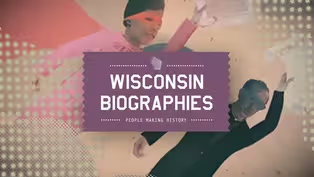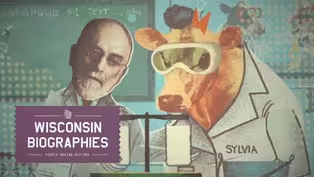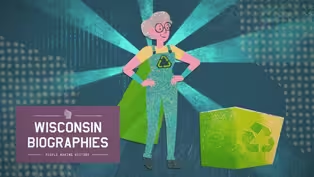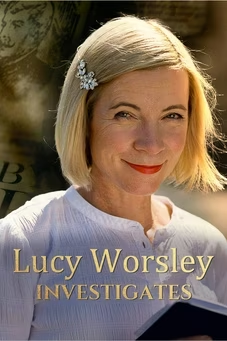
Les Paul: The Search for the New Sound
Special | 4m 40sVideo has Closed Captions
Les Paul’s groundbreaking music techniques are still used today in the music industry.
He heard a unique sound no one had ever heard before and he wanted to share it with the world. Les Paul's natural curiosity and relentless enthusiasm for music, guitar, and electronics propelled this "Wizard from Waukesha" from Wisconsin into music history. His groundbreaking music techniques are still used today in the music industry.
Problems playing video? | Closed Captioning Feedback
Problems playing video? | Closed Captioning Feedback
Wisconsin Biographies is a local public television program presented by PBS Wisconsin
Timothy William Trout Education Fund, a gift of Monroe and Sandra Trout.

Les Paul: The Search for the New Sound
Special | 4m 40sVideo has Closed Captions
He heard a unique sound no one had ever heard before and he wanted to share it with the world. Les Paul's natural curiosity and relentless enthusiasm for music, guitar, and electronics propelled this "Wizard from Waukesha" from Wisconsin into music history. His groundbreaking music techniques are still used today in the music industry.
Problems playing video? | Closed Captioning Feedback
How to Watch Wisconsin Biographies
Wisconsin Biographies is available to stream on pbs.org and the free PBS App, available on iPhone, Apple TV, Android TV, Android smartphones, Amazon Fire TV, Amazon Fire Tablet, Roku, Samsung Smart TV, and Vizio.
More from This Collection
Wisconsin Biographies tells the stories of notable Wisconsinites who have made history. Featured in this compilation: Mohican teacher Electa Quinney, Chippewa activist Walter Bresette, electric guitar pioneer Les Paul, dairy scientist Stephen Babcock and recycling revolutionary Milly Zantow.
Video has Closed Captions
Wisconsin Biographies tells the stories of notable Wisconsinites who have made history. (26m 49s)
Walter Bresette: Treaty Rights and Sovereignty
Video has Closed Captions
Bresette spoke on tribal sovereignty, American Indian treaty rights, and the environment. (4m 10s)
Stephen Babcock: Agriculture’s MVP
Video has Closed Captions
Stephen Babcock invented the Babcock Test at the University of Wisconsin–Madison. (5m 4s)
Milly Zantow: Recycling Revolutionary
Video has Closed Captions
Milly Zantow changed recycling in Wisconsin and the world. (5m 44s)
Electa Quinney: Mohican Teacher and Mentor
Video has Closed Captions
Learn about the life of Electa Quinney, Wisconsin's first known public school teacher. (6m 42s)
Providing Support for PBS.org
Learn Moreabout PBS online sponsorship[lively string music] [guitar strums] - Mike Bloomfield: This is a cherry Les Paul Sunburst guitar.
It's one of the greatest rock and roll guitars ever made.
- Rick Derringer: I just wonder if Les ever had any idea the kind of noise we'd all be makin' with these things.
His involvement in recording and in guitar recording, he's probably the number one man.
[slide guitar] - Les Paul: To begin at the beginning, I was born in Waukesha, Wisconsin.
And about the age of seven, something happened to me.
And I became interested in music and electronics.
I noticed this one fellow was winding this wire around this toilet roll, and I says, "Harry, what in the world are you doin'?"
He says, "I'm making a crystal set.
That's the newest thing, you know."
You can hear radio without no batteries, no nothing.
That led me into electronics very heavily.
So what I did is I stole my mother and father's radio, and I took 'em using this PA system.
To then, I jabbed the pickup needle into the top of the guitar and turned it on, started playin' a record and I played my guitar.
[electric guitar strum] I put that on a hollow-bodied guitar.
An unwanted condition developed.
So you've got a string doin' this and a pickup going up and down on the top of the guitar.
I'm saying, "Hey, only one thing should move, just the string."
No matter what I played from the early '30s on, I was totally convinced I had to pick something close to a solid-body instrument.
♪ Somewhere there's music ♪ ♪ How faint the tune ♪ ♪ Somewhere there's heaven ♪ ♪ How high the moon ♪ ♪ There is no moon above ♪ ♪ When love is far away too ♪ I went to the Gibson people and it took me about seven, eight years to finally convince 'em that this is the way to go.
And I said, "Okay," and we signed.
He says, "With one stipulation.
"We won't use the name Gibson.
What do you suggest?"
And I said, "Well, why don't you call it the Les Paul guitar?"
[electric guitar riffs] - Rick: Les Paul came into the picture.
Up until he really started experimenting with recording techniques, the only way you could record was with several mics, live, on two tracks of tape.
And the entire session had to be balanced accordingly.
If horns were used and they were louder than the bass player, well that meant you put the horns farther away from the mic than the bass player.
And after the record was done, there was nothing to alter it.
[guitar strums] - Les: Bing Crosby asked me one day if I'd record a song with him.
Bing says, "Sounds fine to me."
And he says, "Les, what do you think?"
And I says, "I don't like it."
Bing says, "What's wrong with that record?"
And I says, "Aw, it's technical, Bing."
I says, "There's a lot of things that I desire that are not there."
[electric organ plays] Then the idea hit me, and I says, "I know where it's at.
"It's to stack up this machine with all eight tracks.
I can record each part individually."
Let's see, I've got my wife, Mary.
- Mary: Hi, why don't you grab a guitar and show the people what you can do?
- Les: All right, I got a lot of ideas.
Here we go.
[guitar strums] Now that's one guitar.
Now if you want two, I just throw a switch.
[switch clicks] [guitar doubles] - Mary: How 'bout three?
- Les: Easy.
[switch clicks] [three guitar sounds play] Now if you want four, switch.
[switch clicks] [guitars play] - Mary: How 'bout five?
- Les: It's a cinch.
[switch clicks] [guitars play] Now if you want six, here's a half a dozen, an easy one.
[switch clicks] - Rick: He was really an innovator in modern recording techniques.
It's almost like he was the person who invented the sound of today's pop records.
- Mike: This is it, this is the sound.
[electric guitar plays] ♪ ♪
Support for PBS provided by:
Wisconsin Biographies is a local public television program presented by PBS Wisconsin
Timothy William Trout Education Fund, a gift of Monroe and Sandra Trout.




















